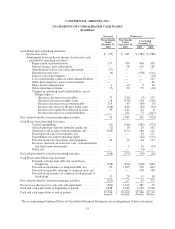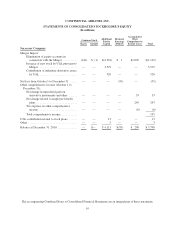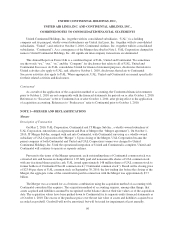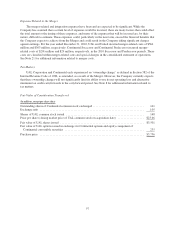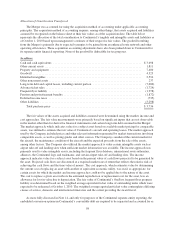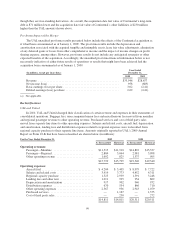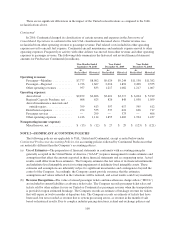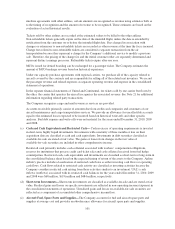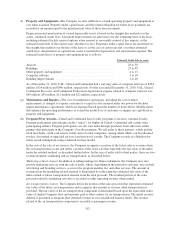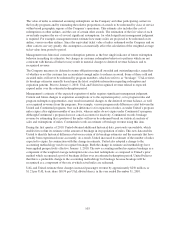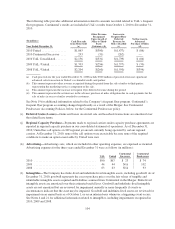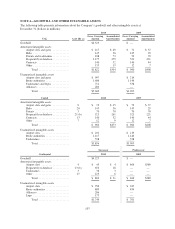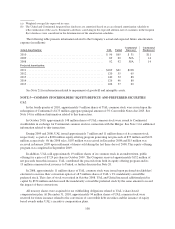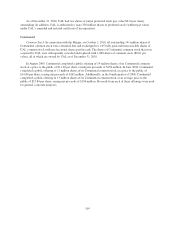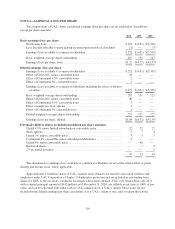United Airlines 2010 Annual Report Download - page 104
Download and view the complete annual report
Please find page 104 of the 2010 United Airlines annual report below. You can navigate through the pages in the report by either clicking on the pages listed below, or by using the keyword search tool below to find specific information within the annual report.
(f) Property and Equipment—The Company records additions to owned operating property and equipment at
cost when acquired. Property under capital leases and the related obligation for future lease payments are
recorded at an amount equal to the initial present value of those lease payments.
Depreciation and amortization of owned depreciable assets is based on the straight-line method over the
assets’ estimated useful lives. Leasehold improvements are amortized over the remaining term of the lease,
including estimated facility renewal options when renewal is reasonably assured at key airports, or the
estimated useful life of the related asset, whichever is less. Properties under capital leases are amortized on
the straight-line method over the life of the lease or, in the case of certain aircraft, over their estimated
useful lives. Amortization of capital lease assets is included in depreciation and amortization expense. The
estimated useful lives of property and equipment are as follows:
Estimated Useful Life (in years)
Aircraft .................................................... 28to30
Buildings .................................................. 25to45
Other property and equipment .................................. 4to15
Computer software ........................................... 5to10
Building improvements ....................................... 1to40
As of December 31, 2010, UAL, United and Continental had a carrying value of computer software of $454
million, $114 million and $340 million, respectively. For the year ended December 31, 2010, UAL, United,
Continental Successor and Continental Predecessor depreciation expense related to computer software was
$69 million, $58 million, $11 million and $22 million, respectively.
(g) Maintenance and Repairs—The cost of maintenance and repairs, including the cost of minor
replacements, is charged to expense as incurred, except for costs incurred under our power-by-the-hour
engine maintenance agreements, which are expensed based upon the number of hours flown. Modifications
that enhance the operating performance or extend the useful lives of airframes or engines are capitalized as
property and equipment.
(h) Frequent Flyer Awards—United and Continental have loyalty programs to increase customer loyalty.
Program participants earn mileage credits (“miles”) for flights on United, Continental and certain other
participating airlines. Program participants can also earn miles through purchases from other non-airline
partners that participate in the Company’s loyalty programs. We sell miles to these partners, which include
retail merchants, credit card issuers, hotels and car rental companies, among others. Miles can be redeemed
for free, discounted or upgraded air travel and non-travel awards. The Company records its obligation for
future award redemptions using a deferred revenue model.
In the case of the sale of air services, the Company recognizes a portion of the ticket sales as revenue when
the air transportation occurs and defers a portion of the ticket sale that represents the fair value of the miles
under the residual method, as described further below. In the case of miles sold to third parties, there are two
revenue elements: marketing and air transportation, as described below.
Marketing-related element. In addition to selling mileage for future redemption, the Company may also
provide marketing services with the sale of miles, which, depending on the particular customer, may include
advertising and branding services, access to the program member list, and other services. The amount of
revenue from the marketing-related element is determined by subtracting the estimated fair value of the
miles earned or future transportation element from the total proceeds. The residual portion of the sales
proceeds related to marketing activities is recorded as other operating revenue when earned.
Air transportation element. The Company defers the portion of the sales proceeds that represents estimated
fair value of the future air transportation and recognizes that amount as revenue when transportation is
provided. The fair value of the air transportation component is determined based upon the equivalent ticket
value of similar Company fares and amounts paid to other airlines for air transportation. The initial revenue
deferral is presented as frequent flyer deferred revenue in our consolidated balance sheets. The revenue
related to the air transportation component is recorded as passenger revenue.
102



